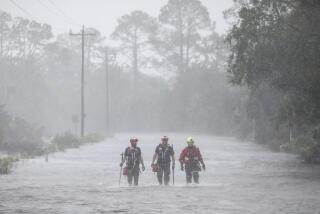Irene strengthens to Category 2 storm, threatening U.S. coast
Hurricane Irene grew into a Category 2 storm that is forecast to strengthen as it moves toward the Bahamas and possibly the Carolinas and the Northeast U.S.
Irene’s maximum sustained winds remained at 100 miles per hour, up from 80 mph yesterday. It may become a major hurricane later today, according to an advisory. The storm’s winds may increase to 111 mph, according to a statement yesterday.
“I don’t see any roadblocks to intensification over the next four or five days,” said Jeff Masters, co-founder of Weather Underground Inc. in Ann Arbor, Michigan. “The ocean temperatures are 1 to 1.5 degrees warmer than average this year. Climatologically, conditions are conducive for strong hurricanes tracking far to the north this year.”
Losses from Irene in Florida, Georgia and the Carolinas may total $2.2 billion and cost insurers $1.2 billion, according to an initial estimate by Kinetic Analysis Corp., a risk-modeling firm in Silver Spring, Maryland. The hurricane’s current projected path brings it ashore somewhere near the border between North and South Carolina on Aug. 27.
The hurricane center says predictions of where a hurricane may strike land are often inaccurate. The five-year average of errors for a four-day prediction is 200 miles, and for a five- day forecast, it is 250 miles.
“All of the ingredients are conducive for Irene to intensify over the next few days,” according to a hurricane center forecast analysis prepared by Lixion Avila, a senior hurricane specialist at the center. The computer models “insist on making Irene a large and strong hurricane.”
There is a chance Irene may pass over Long Island next week as a strong tropical storm, said Masters, who began his career flying on National Oceanic and Atmospheric Administration hurricane reconnaissance planes. One such plane investigated Irene late yesterday and that mission should improve computer model error rate by 20 percent.
New York City has been tracking the storm since it first appeared off the coast of Africa last week, said Chris Gilbride, a spokesman for the Office of Emergency Management.
It probably would be a “heavy rain event,” not a hurricane, if it reaches New York, he said.
“The storm is not likely to stop in the Carolinas,” meteorologist Alex Sosnowski wrote on AccuWeather Inc.’s website. “It is very possible strong-tropical-storm or even hurricane conditions will continue to spread up the Atlantic Seaboard.”
Earlier yesterday, forecasters predicted the storm was heading to Florida. As they received more information “the current guidance lessens the threat to south Florida,” according to the hurricane center.
The storm probably won’t enter the Gulf of Mexico, home to 31 percent of U.S. oil output and 7 percent of natural gas.
“As far as energy purposes, it looks like the Gulf is going to get away from this one,” said Travis Hartman, a meteorologist with MDA EarthSat Weather in Gaithersburg, Maryland.
The hurricane center expects Irene to pass just north of Hispaniola, home to Haiti and the Dominican Republic, later today. Irene will veer northward over the next few days, taking it across the Bahamas late tomorrow and to the east coast of Florida by Aug. 25, the center said.
American Airlines and its American Eagle regional carrier, along with JetBlue Airways Corp. and US Airways Group Inc., canceled 124 flights today between the U.S. and the Caribbean, as well as among the islands themselves, according to spokesmen for the companies.
Florida’s orange crop is vulnerable to tropical weather if the area is exposed to strong winds. Futures for November delivery rose 0.9 percent yesterday to $1.6565 a pound on ICE Futures U.S. in New York.
“It’s a bit of a wait-and-see at this point in time. We need to get a couple days nearer to see what the damage is going to be” to the crop, Jim Dale, a senior risk meteorologist at British Weather Services at High Wycombe, England, said in a telephone interview.
Hurricane warnings have been issued for the north coast of the Dominican Republic, the southwest and central Bahamas and the Turks and Caicos Islands, while watches are in force for the north coast of Haiti and the northwestern Bahamas. Warnings are issued for areas where hurricane-force winds are expected within 36 hours and a watch is issued when there is a possibility of hurricane-force winds within 48.
Hurricane-force winds extend outward for 45 miles from Irene’s core, up from 15 miles yesterday, and tropical-storm- force winds extend for 185 miles, the center said in its advisory.
The storm may drop 5 to 10 inches of rain across the southeastern Bahamas and the Turks and Caicos islands, with lesser amounts elsewhere, the hurricane center said.
A storm becomes a hurricane when winds hit 74 mph. The last hurricane to hit the U.S. was Ike in 2008, which was a Category 2 storm on the five-step Saffir-Simpson Hurricane Wind Scale when it went ashore near Galveston, Texas. The last major hurricane, with winds of at least 111 mph, to hit was Hurricane Wilma in 2005.
More to Read
Start your day right
Sign up for Essential California for news, features and recommendations from the L.A. Times and beyond in your inbox six days a week.
You may occasionally receive promotional content from the Los Angeles Times.






